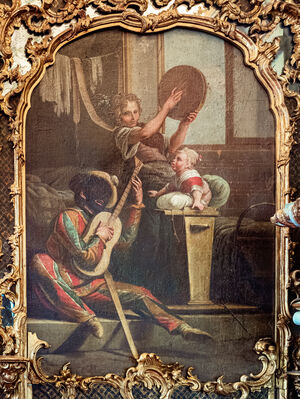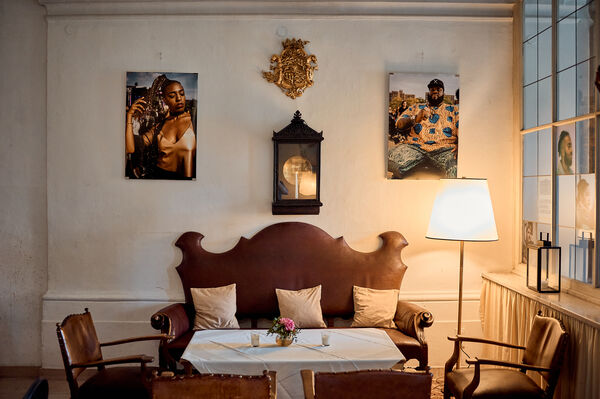

In 2018, a group of young Salzburg Global Fellows protested the presence of blackface in the depictions of Othello in the Max Reinhardt exhibition in the Meierhof hallways and of Harlequin in the commedia dell’arte-inspired panels of the Venetian Room, and the cultural appropriation of the Chinese Room. Both these rooms had been installed by Max Reinhardt almost a century earlier, but cultural norms do not stand still and what was once considered acceptable—even beautiful—can now be seen as distasteful and offensive. Blackface has long been used in productions of Shakespeare’s Othello and the 16th century black-masked Harlequin figure has been credited with inspiring minstrelsy in 19th century America. Seen by some as a reflection of China’s rising power but by others as “othering” and needless exoticizing of Asia, chinoiserie also has a complex legacy vis-à-vis cultural appreciation and appropriation.
Since that 2018 protest, Salzburg Global has undertaken a comprehensive review of the artwork and other elements of Schloss Leopoldskron’s cultural history, heritage and representation and has begun to re-curate several spaces. It has engaged advisors from across its global Fellowship, including artists, art historians, museum curators, and other academics from the US, Africa, Asia and Europe, to help determine a course of action. Unsurprisingly for such a contentious issue, there has been little consensus. Some have advocated better contextualization. Others called for the total removal and remodeling of both rooms. Salzburg Global’s approach thus far has been to add further layers to the historic building, rather than large scale removals. The Othello images were replaced with those from other Reinhardt productions and contextual placards were added to the Venetian and Chinese Rooms as well as elsewhere throughout the Schloss. A further inventory of artwork will be conducted, with some marked for removal and new artworks curated and commissioned. Some existing artworks will be highlighted to better showcase the alignment between past and present values, such as the statue of Guan Yin—the transgender deity who has been adopted as the unofficial “protector” of the Salzburg Global LGBT* Forum after it was “discovered” by an Indonesia-based Fellow attending the Forum’s first program in 2013.

New artworks will ensure that the richness and diversity of Salzburg Global’s programs and Fellows are made manifest throughout its facilities and increase the visual representations of its mission and values
throughout the property. Since 2019, Fellows’ work has been exhibited in the Bierstube and the Meierhof Café and Reception, including Brazilian street artist Mundano, American photographers Jose Cotto and Yasmine Omari, and First Nations Australian Louisa Whettam. More recent acquisitions include a large-scale drawing titled The Family in the Sun by South African illustrator Siphiwe Ngwenya, which hangs prominently in the Meierhof Lobby, and a portrait of Salzburg Global Fellow, American politician Stacey Abrams by fellow US Fellow, painter Phillip Simpson, which hangs outside Fellows Hall and will anchor a growing installation of Fellows’ portraits. Further curation, with support from the Packard Foundation, is ongoing to transform the Gallery, Great Hall, and three-story marble stairwell of Schloss Leopoldskron into more modern, inclusive and welcoming spaces.
75 Years in 12 Vignettes
With 75 years behind us and more than 40,000 Fellows in 170 countries, Salzburg Global obviously has many stories to tell. The following 12 vignettes have been selected not only for their ability to relate the history of the institution, but also to convey the unlikely symbiosis of a visionary enterprise, conceived at an American university that came to be situated in an eighteenth-century rococo palace in the heart of Europe with the goal of serving the global good.
